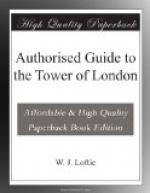On the walls are portions of horse armour, bucklers for foot soldiers, and several shields simulating the embossed ornamentation of the sixteenth century.
The Parade.
The Waterloo Barracks are opposite, built in 1845 on the site of storehouses burnt in 1841. The building of similar character to the right is the Officers’ Quarters: between the two a glimpse is obtained of the Martin or Brick Tower, whence Blood stole the crown in 1671. Observe, on the left, the extensive collection of cannons of all ages and countries, including triple guns taken from the French, of the time of Louis XIV, and some curious and grotesque mortars from India.
Observe, on the right, almost adjoining the Barrack, the Chapel of St. Peter “ad Vincula,” so called from having been consecrated on that well-known festival of the Latin Church, the 1st of August, probably in the reign of Henry I (1100-1135). The old chapel was burnt in 1512, and the present building erected only in time to receive the bodies of the first victims of the tyranny of Henry VIII. It was considered a Royal Chapel before 1550; the interior is not shown to the public. Here it is, in the memorable words of Stow, writing in the reign of Queen Elizabeth, that there lie before the high altar, “two dukes between two queens, to wit, the Duke of Somerset and the Duke of Northumberland, between Queen Anne and Queen Katharine, all four beheaded.” Here also are buried Lady Jane (Grey) and Lord Guildford Dudley, the Duke of Monmouth, and the Scotch lords, Kilmarnock, Balmerino, and Lovat, beheaded for their share in the rebellion of 1745. The last burial in the chapel was that of Sir John Fox Burgoyne, Constable of the Tower, in 1871.
The space in front of the chapel is called Tower Green, and was used as a burial ground; in the middle is a small square plot, paved with granite, showing the site on which stood at rare intervals the scaffold on which private executions took place. It has been specially paved by the orders of Her late Majesty. The following persons are known to have been executed on this spot:—
1. Queen Anne Boleyn, second wife of Henry VIII, 19th May, 1536.
2. Margaret Countess of Salisbury, the last of the old Angevin or Plantagenet family, 27th May, 1541.
3. Queen Katharine Howard, fifth wife of Henry VIII, 13th February, 1542.
4. Jane Viscountess Rochford, 13th February, 1542.
5. Lady Jane (Grey), wife of Lord Guildford Dudley, 12th February, 1554.
6. Robert Devereux, Earl of Essex, 25th February, 1601.
They were all beheaded with an axe except Queen Anne Boleyn, whose head was cut off with a sword by the executioner of St. Omer, brought over for the purpose. The executioner of the Earl of Essex was not able to do his work with less than three strokes, and was mobbed and beaten by the populace on his way home. The bodies of all six were buried in the Chapel of St. Peter.




